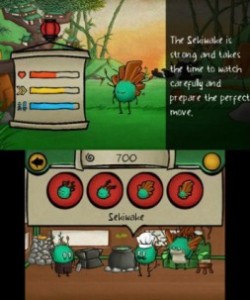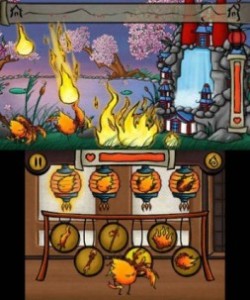Cocoro Line Defender Review
There are only so many variables a line defence game can change to differentiate itself from the crowd. Cocoro’s big sell is “more than 90 unit combinations” tied into an elemental war taking place in “mythological Japan”. Is this enough? Not really.
You’re introduced to the story by a short animation. The four elements – fire, earth, water and wind – are warring for control of the world, taking turns at narrating their side of the story. This could have been the standout feature Cocoro needs: multiple perspectives on the same story showing the age-old adage that history is written by the victor. Sadly though, this is all the narrative you’re given.

When you switch between sides you’re treated to a panel showing one element’s storyteller interrupting the one you’ve just been controlling, with a variation on “that’s not how it happened”. It’s just a confusing mess of alliances and contradictions with no real plot. It’s impossible to tell who is winning or losing the war – especially given that you control all the sides, and thus they all win at some point. But if the story is a mess then perhaps the gameplay can salvage Cocoro: 90 unit combinations have to count for something right?
Well the best I can say is that it’s not bad. As per a standard line defence game, you have a 2D level with a base on each side, yours on the left, your opponent’s on the right. You spawn units who start at your side and move right, while your opponent does the same in reverse. The winner is whoever destroys the enemy’s castle first. Simple.
Challenge comes in the various units you can spawn. There are four base warriors, from quick but weak through to slow but tough, which unlock as you progress through the story. The unit combinations come from the choice of weapon, starting of with a sword of the respective element to bows and arrows and the like. Units generate automatically; the better they are the slower the timer, and you can change the next unit’s weapon while it is spawning. It’s all simple but efficient: all these options are mapped to the touchscreen while the main screen shows the battlefield.

When a unit spawns it appears in your base, and from there you have to fling it into the battlefield. This is Cocoro’s best feature: most line defence games will just spawn units from the base, but there is an extra tactical depth to proceedings – you could bypass a brute and go straight for the weaker archers behind him – as well as skill involved in judging how far to fling a unit.
Which makes it all the more tragic that Cocoro involves almost zero challenge. Tactics never come into it: weaker units can be one-shotted by tougher enemies, meaning you have to at least match the units your opponent is using, at which point it comes down to weapons. This is further confounded by the need for multiple archers or spear throwers to make the units effective – although they will be slaughtered if they’re not behind a melee soldier, and with such slow spawning times for higher end units they become impractical.
After each battle you’ll often receive a new unit or weapon, with the following battle easily winnable if you spam that one unit, normally the toughest. If that doesn’t work then the second option it to max out all available weapon upgrades, bought with points gained from battle. In practise, you either steamroll a level or lose and still gain enough points (you get some from a level no matter what) to fully upgrade your weapons until you win. It’s worse towards the endgame where you may have to grind a battle several times to afford the upgrades needed to win.

The upgrades you have don’t carry over between the four sides you flit between, either. In fairness the opponents are similarly levelled – it won’t expect you to beat an enemy with the toughest warrior when you only have the basic one – but it means that you have to go through the entire process of grinding and levelling four times. It would perhaps be understandable if the armies were wildly different, but they aren’t. That “90 unit combinations” is inaccurate: with four of the five available weapons for each side the same, each element only has one differentiating weapon, a fireball for Fire or a health-giving lute for Earth. Why not just have one upgrade path for them all?
The answer, of course, is padding. Cocoro does everything it can to make you forget that you’re playing the same level over and over again. You spam the best unit repeatedly, win, get upgrade, spam the new best unit, win, get upgrade, etc. Even the campaign features the same battle from various perspectives, just to make the experience longer.
VERDICT: The bottom line is that Cocoro doesn’t do anything that you can’t get from the hundreds of free line defence games on the net. It tries to set itself apart, with a storyline and customisable units, but it all rings a little hollow. After grinding for the umpteenth time, you’ll realise it’s the same thing, over and over again.

AVERAGE. The epitome of a 50/50 game, this title will be unspectacular but inoffensive, charmless but amiable. We aren’t condemning a game by scoring it a 5, but we certainly aren’t championing it, either.
Review code provided by publisher.




